Review for Sword of the Stranger
Introduction
By the time I got to the Beez party, it was all over, the company had closed up shop. Review discs kept me in clover when it came to Manga and MVM, and for a brief time Revelation, and also got me buying those titles that I missed out on reviewing from those companies. I also stocked up on ADV titles when I saw the kind of gems they released. But Beez was always a little too expensive for my tastes, especially when I got the very same titles for half the price directly from Bandai, their US stable-mates. But when I did eventually get a few Beez titles, I could see where that extra money went, especially when it was something like the Patlabor movie special editions! Also, Beez really did act as pioneers when it came to certain anime in the UK; certainly they championed an epic franchise like Gundam where you would expect the average distributor to balk at its sheer size. They also paved the way for anime on Blu-ray in the UK, practically being the first out of the blocks with their release of the Freedom OVAs and Gunbuster vs. Diebuster, a year ahead of Manga Entertainment’s first Blu-ray. Alas Blu-ray was just not a viable format for Beez, and from what I can tell, they released just one other Blu-ray title, two years later.
It’s that title, Sword of the Stranger that I take a look at for this review. Oddly enough, I missed this Studio Bones feature film the first time around. I’d heard that it was a period samurai flick, and I also heard comparisons to Ninja Scroll. That was in my ‘down on Ninja Scroll’ period, and I also wasn’t in the mood for po-faced samurai posturing. I chose to forego the film on DVD and divert my expenditure elsewhere. But, when I did eventually get Blu-ray’d up, and went looking for high-definition anime to spend money on, the Sword of the Stranger disc called to me where its DVD equivalent did not. I bought this disc, rapidly heading for OOP status, ready for the next Ninja Scroll, prepared for some sword-wielding masculinity. It turns out that Sword of the Stranger is neither of these things.
Politics is happening in feudal Japan. The Ming Chinese are there, selling their gunpowder weapons, but they have an ulterior motive. They’re looking for a young boy named Kotaro for the greater glory of their emperor, and what they have in mind for the child isn’t benevolent. A sympathetic priest helped the boy escape with his dog, and pointed him in the direction of a sanctuary, but a boy alone in the war torn country is going to have a hard time just staying alive. It’s sheer coincidence that he runs into a nameless samurai at the same time that the Chinese army catch up to him, and subsequent events prove that the nameless samurai is best suited to be Kotaro’s bodyguard. He’ll have his work cut out persuading him, and it doesn’t look like the two will ever get along. They’ll have to work something out, as the Chinese have among their number a blonde-haired, blue-eyed mercenary, a master swordsman who is in Japan looking for the ultimate foe to test his blade.
Picture
Sword of the Stranger gets a 1.78:1 widescreen transfer at the 1080p resolution. It’s an exquisite transfer, clear and sharp throughout, bringing across its limited autumnal and winter colours without flaw. The animation is smooth and detailed, the backgrounds atmospheric and stylised, with a watercolour feel to the scenery, and the action simply looks amazing. The character designs are memorable and well realised, and there are no signs of compression or indeed even the perennial digital banding which is all I really get to whinge about when it comes to anime on Blu-ray.
Sound
You have the choice between DTS-HD MA 5.1 English, Japanese, Spanish, and DD 5.1 Catalan (not Dolby TrueHD as listed on the case) with subtitles in English, French, Spanish and Catalan, as well as signs only (and Mandarin translations) tracks in French and English.
I went with the Japanese audio and found it to be an exemplary surround track, really bringing across the action with panache, and making the most of the film’s memorable music. The Chinese characters, when interacting with the Japanese speak Mandarin (that’s true in the English dub as well) and subtitles are there quite necessarily. The subtitles may have the odd typo, but are otherwise clear and accurately timed. I did find the font a little small and blocky though.
Extras
Sword of the Stranger’s Blu-ray comes from a time when reverse importation wasn’t a concern for Japanese distributors, hence the Region free nature of the disc (note that the menus are presented in 1080i 50Hz), the technical qualities of the transfer are top notch, and you have complete control over the film’s audio and subtitle options. You also get more than you normally would in terms of extras.
The animated storyboards last 3 minutes, and offer a little pre-vis work for the film’s action sequences.
The Staff Interviews really amount to a 49 minute making of featurette, taking us from the film’s conception to theatrical release, with interviews with all concerned. This is more than just the usual puff-promotional material that comes with new release movies, and the staff go into quite some depth about the making of the film. There are looks too behind the scenes of the film, with the voice recording and the music soundtrack composition examined.
Cast Interviews last 17 minutes and offers interviews with the voice actors behind the main characters, Tomoya Nagase (No Name), and Yuri Chinen (Kotaro). It’s interesting to see that they cast a boy of similar age to Kotaro, instead of going with an older female voice actress as anime companies usually do.
There are 4 minutes worth of theatrical trailers, a minute of TV spots, and the 4 minute Pilot Film that served as proof of concept for the idea of a period samurai action anime movie.
All of the extras are presented in 1080i 60Hz resolution.
Conclusion
Sword of the Stranger has samurai in it, and it’s a period movie, but don’t go into it expecting the next Seven Samurai or Yojimbo, although it does come off as a distant descendant of these films. Sword of the Stranger is really more of a buddy movie crossed with a Spaghetti Western. That’s the convoluted connection, as films like The Magnificent Seven and A Fistful of Dollars were indeed remakes of Kurosawa movies. But what Sword of the Stranger does with character, with action sequences, and with directorial panache owes much more to Leone than it does to Kurosawa. This is one, cool period action film, and it’s the best anime feature I have seen in years.
The heart of the film is the relationship that develops between Kotaro and the nameless ronin. The child Kotaro is on the run, having lost his family, and his sanctuary, and with only his dog to call friend. He’s defensive, self-reliant, and quite bratty, even though the world has given him no reason to be trusting of anyone. No-Name on the other hand is a man running from battle, from his past as a samurai. He has no desire ever to draw his sword again, but somehow reluctantly winds up acting as bodyguard to Kotaro, with the promise of payment if he can escort him to safety. They don’t trust each other at first, and it’s a prickly relationship. But as they get to know each other, Kotaro finds someone that he can trust, while No-Name realises that there is something worth fighting for after all.
But the meat of the film is in the action. Both No-Name and the villain of the piece are outsiders, strangers, given their odd heritages, but No-Name has found a way to fit in to Japanese society. Luo-Lang on the other hand makes no effort to hide his strangeness, a blonde haired and blue eyed warrior who works with the Chinese, but is clearly not of them, and whose only real ambition is to find a foe worthy of his sword skills. In his introduction in the film, it become clear that even the warrior tradition of Japan yields no such foe capable of standing up to him. But when he encounters the other outsider No-Name, it’s then that he finds someone worth fighting, someone worthy of his respect. They are interesting archetypes, with Luo-Lang feeling most alive when he is fighting, and No-Name feeling most alive when he is in pain. That last is most challenging for Luo-Lang, as his fellow Chinese warriors dull the pain they feel in battle with drugs.
The fight sequences are absolutely stunning, brilliantly choreographed, and visually engaging. You can see each move, each dodge, feint, parry and strike with absolute clarity; you can understand the narrative of each fight, the deadly dance that it entails. Sword of the Stranger has the best sword-fighting action I have seen since the Darth Maul fight in The Phantom Menace. And then you realise it’s a 2D animation...
If there is a weakness, it’s a small one, and one that is easy to forgive. The story isn’t that well defined. The Chinese want Kotaro for a certain ritual, one that will increase the power of the Emperor, and for it they construct a fantastic device, a grand altar on which to perform their sacrifice. The reasoning behind this is never really made clear. Just what is so special about Kotaro that only he will do, and how do the Chinese believe that this ritual is supposed to work? Those are the niggling nitpicks of a viewer who needs all of the answers.
But answers and complexity of narrative aren’t what Sword of the Stranger is about. It’s about the relationship between Kotaro and No-Name, it’s about the brilliant action sequences, it’s about the atmosphere and style, and it’s about the amazingly vivid and memorable direction. This should be on the shelf of every anime fan, it should be on the tip of critic’s tongues when asked for the best that anime can offer along with films like Akira, Ninja Scroll and Ghost in the Shell, and it really ought to have been lavished with awards when it was first released. Maybe now is the right time for a rediscovery.
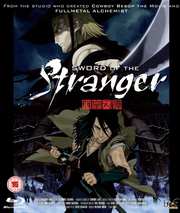
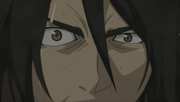

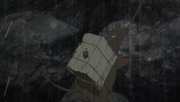


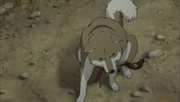
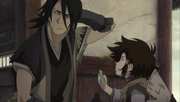
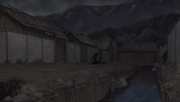
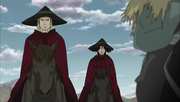
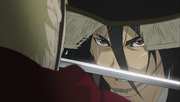
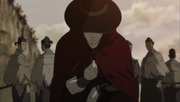

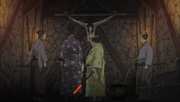
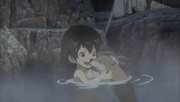
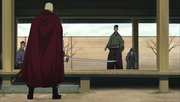

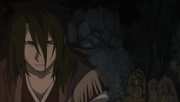


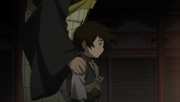
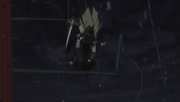
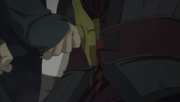



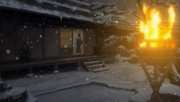
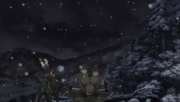
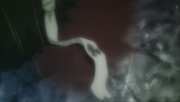
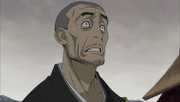
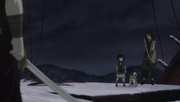




































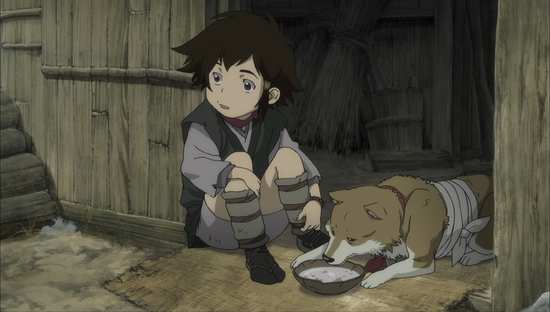


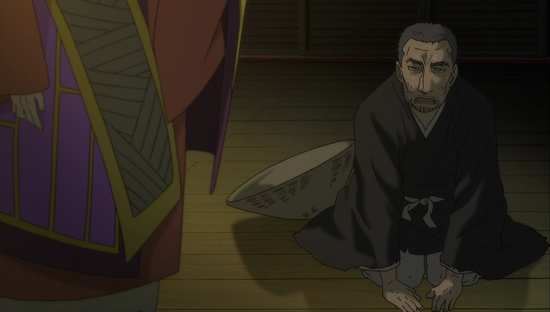

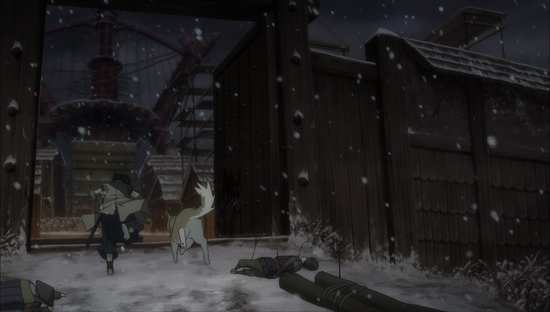



Your Opinions and Comments
Be the first to post a comment!